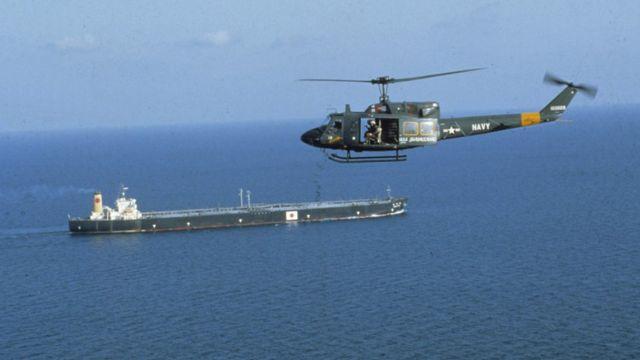Tankers ablaze in the Gulf, American warships responding to distress calls, and hostile rhetoric that raises fears of a wider conflict in the region.
“We have seen this before, that is, 28 years ago, America and Iran collided in the same waters, and ships were attacked, killing and wounding members of their crews.
Before it was over, an Iranian airliner was mistakenly shot in the sky.
Could this happen again?
The Tanker and Cargo War was a moment of heightened international tension at the end of the eight-year Iran-Iraq war.
Both sides have been attacking each other's oil facilities since the mid-1980s.
Neutral ships soon came under attack, as the warring nations tried to exert economic pressure on each other, and Kuwaiti tankers carrying Iraqi oil, in particular, were at risk.
The United States, led by Ronald Reagan, was reluctant to do so, but the situation in the Gulf became increasingly dangerous, especially when the US warship, the USS Stark, was hit by Exocet missiles fired from an Iraqi aircraft, which Iraqi officials later claimed was an accident.
By July 1987, American warships were escorting Kuwaiti oil tankers flying the American flag. Over time, the area became a route for the largest sea convoys since World War II.
Over time, the dispute between America and Iran increased.
Iran's Supreme Leader, Ayatollah Khomeini, has been describing America as the "Great Satan" since the Iranian Islamic Revolution in 1979.
The period between 1979 and 1981 witnessed a great American grumble because of the shame and humiliation inflicted on it as a result of Iran holding 52 of its diplomats hostage for 444 days.
Although Iran and Iraq were responsible for the crisis, the tanker war has notably become part of the long-running dispute between Iran and America.
This conflict has never disappeared, but rather re-emerged strongly in the wake of Donald Trump's decision to withdraw from the 2015 Iran nuclear deal and impose severe sanctions on Iran.
The waterway, the Strait of Hormuz, has once again become an arena for confrontations between Tehran on one side and Washington and its allies on the other.
Has anything changed?
"Both sides have expanded their capabilities," says Dr. Martin Navias, author of a book on tanker warfare.

He adds: Iran is more capable than ever of using mines, submarines, and speedboats to attack and destroy military ships and commercial cargo ships.
He added, "It is no longer just a battle at sea. Iran's ability to shoot down an advanced American reconnaissance plane indicates another battle, there in the air."
Could the two sides start exchanging painful blows?
If attacks on oil tankers escalate, the region could see a resurgence of US warships escorting tankers and cargo ships into the waterway once again.
On July 24, 1987, a Kuwaiti tanker carrying an American flag hit an Iranian mine in the first flotilla escorted by protection ships, which prompted the United States to deploy more troops and ships, and put the two sides on a collision course more than before.
In September of the same year, American helicopters attacked an Iranian ship after witnessing it laying mines at night.
Months later, an American frigate and other ships were bombed, prompting American forces to respond more forcefully than ever, destroying Iranian Revolutionary Guard bases and attacking Iranian warships.
In the end, the war ended. But not before the American cruiser USS Vincennes rammed and shot down an Iranian Airbus A300, mistaking it for an attack warplane, killing all 290 passengers and crew.
"Stress, the nature of the mission and unintended data inconsistencies may have played a major role in the accident," the official report on the accident said.
This event prompted the US Navy to invest heavily in technology and training to avoid such catastrophic mistakes in the future.
But Nick Childs, a marine analyst at the International Institute for Strategic Studies, ISS, says the environment we live in today and competitors exchanging angry alerts on social media is making the atmosphere feverish.
"The information space has changed, people are worried. The danger is that each side is misreading the other."
And he added: It is clear that Donald Trump and Hassan Rouhani do not want war. But hardliners on both sides are more ambiguous.
We haven't gone to another tanker war yet, Dr. Navias says.
"We are not witnessing a campaign against tankers and cargo ships, but we are witnessing a campaign of threatening signals and messages. The Iranians are sending signals to the Americans that they may ascend," he adds.
Despite all the drama of 1987 and 1988, very few tankers actually sank, and shipping through the strategic Strait of Hormuz never stopped in earnest.
Now, 30 years later, the United States is less dependent on Middle Eastern oil, and Iran has a lot to lose in terms of imports and exports if the strait is closed.
At the moment, another tanker war seems unlikely, but the fact that no one really wants an all-out confrontation does not mean that one will not happen.
The risks are real, says Dr. Navias, and "this kind of environment is full of possibilities".
